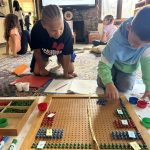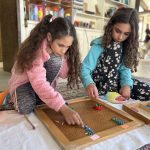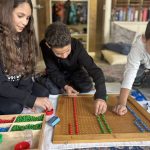Ancient Egyptians believed that upon death they would be asked two questions and their answers would determine whether they could continue their journey in the afterlife. The first question was, ‘Did you bring joy?’ The second was, ‘Did you find joy?’ -Leo Buscaglia
Upper Elementary students returned to school this week, enthusiastic about our new history studies on Ancient Civilizations.
We began our study with discussions about the definitions of society and civilization, followed by an introduction to the building blocks of civilization. We learned that each stage in the evolution of human culture builds on the foundations of previous societies, with each stage showing advancements from earlier ones. The stages we examined included big game hunting, foraging, farming, trading, and the formation of cities.
Next, we looked at the timeline of the Holocene Epoch, divided into 500-year segments, and features a map highlighting some of the world’s earliest civilizations. The upper part of the timeline focuses on Eurasia and Africa, while the lower part emphasizes developments in the Americas. The Africa-Eurasia map highlights the Mesopotamian civilizations along the Tigris and Euphrates Rivers in the Middle East, the Egyptian civilization along the Nile in northwestern Africa, the Indus River civilization in northwest India, and the Shang civilization north of the Yellow River in China. Meanwhile, the Americas map highlights Mesoamerica and the highlands of Peru. This timeline clearly illustrates that civilizations developed in various ways and at different rates, depending on the conditions of their environments.
Upper Elementary students study ancient civilizations to understand them as an evolutionary stage and to relate to the process of civilization development. They are encouraged to challenge the notion of a simplistic, linear progression of human advancement and to identify significant events in civilization’s history. We will explore the contributions of different cultures, hoping to inspire each student’s curiosity for further studies in this area. As we learn about the development of civilizations, we will examine how each group addressed specific fundamental needs and expressed basic human tendencies, comparing and contrasting different societies. Each study will focus on geography, cultural activities, everyday life, and political and economic systems.
Next week, we will choose four ancient civilizations, and students will begin work in small groups, each focusing on one civilization. Over the next seven weeks, they will collaborate to complete their research at school and will present their findings to peers and parents at Research Night on Wednesday, March 5, at 5:30.
This upcoming Wednesday, Upper El students have been invited to participate in National Hat Day by wearing their favorite hats to school.












































































































































































